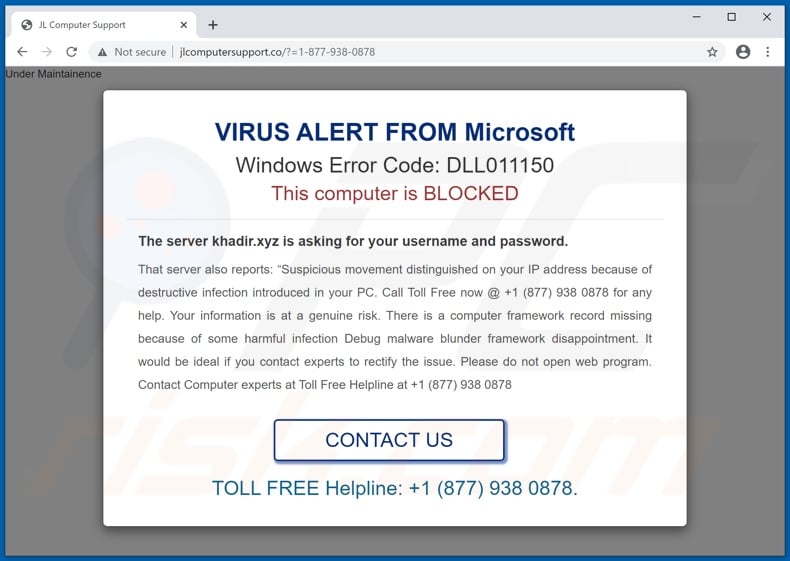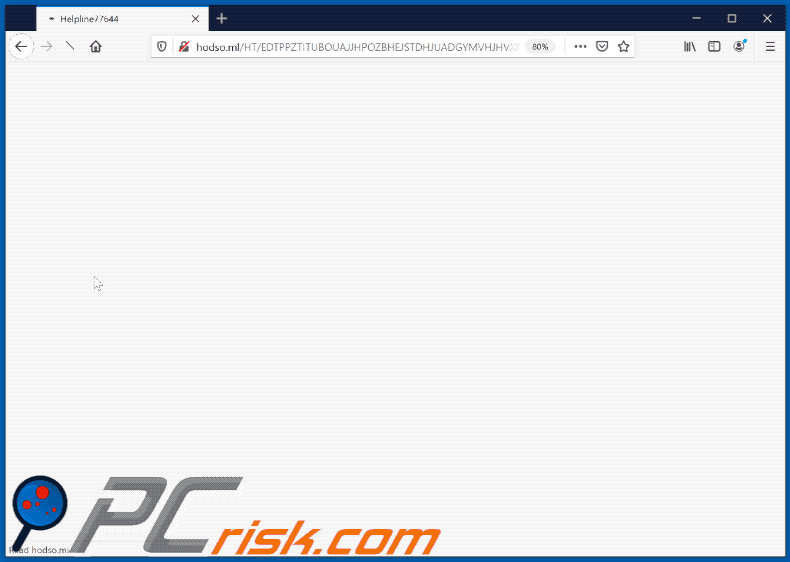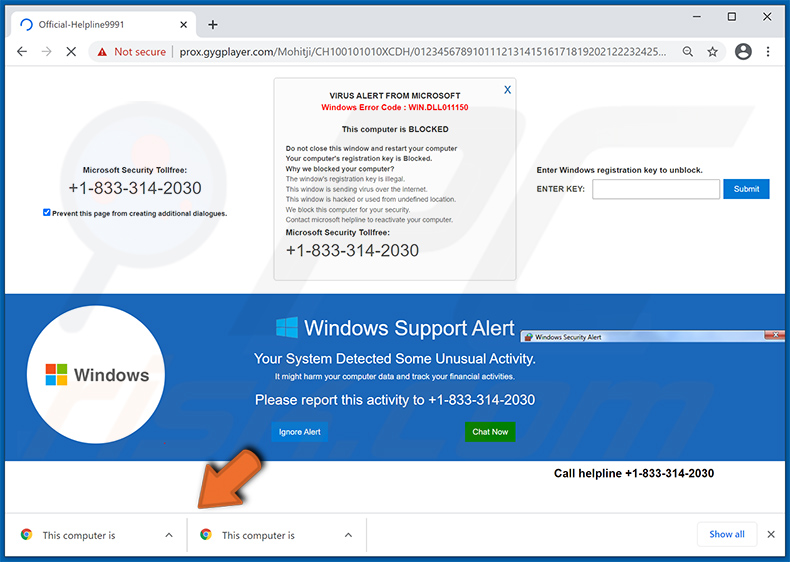Do not trust scam websites displaying "Windows Error Code: DLL011150"
Phishing/ScamAlso Known As: Windows Error Code: DLL011150 tech support scam
Get free scan and check if your device is infected.
Remove it nowTo use full-featured product, you have to purchase a license for Combo Cleaner. Seven days free trial available. Combo Cleaner is owned and operated by RCS LT, the parent company of PCRisk.com.
What is the "Windows Error Code: DLL011150" scam?
"Windows Error Code: DLL011150" refers to a technical support scam run on various deceptive websites. This scheme claims that it is a "virus alert" from Microsoft, informing users that their devices have been supposedly blocked due to suspicious activity detected on them.
All of the information provided by "Windows Error Code: DLL011150" is false and this scam is in no associated with the Microsoft Corporation. Users rarely access sites that promote these scams intentionally, most enter them through mistyped URLs, are redirected to them by intrusive advertisements, or by Potentially Unwanted Applications (PUAs).
These apps do no need express user permission to be installed onto systems. PUAs cause redirects, run intrusive advertisement campaigns, hijack browsers and collect browsing-related information.

Once a site running "Windows Error Code: DLL011150" is accessed, visitors are presented with a pop-up window with the text presented within it heard on audio. The scheme states that it is a "virus alert from Microsoft" and that the user's computer has been blocked.
According to the pop-up, the device was allegedly locked due to suspicious activity detected on the user's IP (Internet Protocol) address, which in turn was caused by a (nonexistent) system infection. The scam then lists fake issues already present on the device and urges visitors to contact tech support experts via the provided telephone number.
Despite the fraudulent helplines being presented as toll-free, they are frequently very expensive. Typically, scammers attempt to gain access to the computers of potential victims, claim to fix the nonexistent problems and demand exorbitant fees for their "services".
In the best case scenarios, victims devices remain unharmed, however, more commonly, scammers remove any legitimate anti-virus programs and install and/or trick users into purchasing fake ones, infect the devices with malware and extract personal/financial information.
The malicious software they install can be Trojans, ransomware, cryptominers and various other malicious programs. Scammers often infect their victims' machines with Remote Access Trojans (RATs) to gain indefinite access and control over the computers without the owners' knowledge.
Additionally, scammers ask users to provide vulnerable information such as names, surnames, addresses, emails, banking account and/or credit card details. Rather than outright asking for this data, scammers may ask users to enter it into phishing websites, which are disguised and/or function as payment gateways.
The preferred payment methods for the "services rendered" typically deal with digital currencies (e.g. pre-paid vouchers, gift-cards, cryptocurrencies, etc.), which are difficult/impossible to trace. Furthermore, scammers usually target victims repeatedly, if their initial scam attempts are unsuccessful.
To summarize, trusting the "Windows Error Code: DLL011150" scheme can result in system infections, financial loss, serious privacy issues and identity theft.
As mentioned, one of the main causes of rogue redirects to deceptive/scam pages are PUAs. These applications have various capabilities in varied combinations, as well as force-opening harmful websites. Adware-types deliver intrusive ads, which significantly diminish the browsing experience.
When clicked, the delivered ads redirect to dubious/dangerous sites and some can even stealthily download/install rogue software. Browser hijacker type PUAs modify browser settings and restrict access to them to promote fake search engines.
The promoted web search tools are seldom able to generate unique results, and so they redirect to Google, Yahoo, Bing and other legitimate search engines. Most PUAs (regardless of type) have data tracking capabilities.
They can record browsing activity (browsing and search engine histories) and collect personal information extracted from it (IP addresses, geolocations and other details). The gathered data is then shared with and/or sold to third parties (potentially, cyber criminals).
Therefore, to ensure device integrity and user safety, all suspicious applications and browser extensions/plug-ins must be removed without delay.
| Name | Windows Error Code: DLL011150 tech support scam |
| Threat Type | Phishing, Scam, Social Engineering, Fraud. |
| Fake Claim | Scam claims users' computers have been blocked due to suspicious activity detected on them. |
| Disguise | Scam is disguised as a virus alert from Microsoft. |
| Tech Support Scammer Phone Number | +1 (877) 938 0878, +1-833-220-3898 |
| Related Domains | jlcomputersupport[.]co |
| Detection Names (jlcomputersupport[.]co) | Netcraft (Malicious), Full List Of Detections (VirusTotal). |
| Serving IP Address (jlcomputersupport[.]co) |
166.62.28.148 |
| Symptoms | Fake error messages, fake system warnings, pop-up errors, hoax computer scan. |
| Distribution methods | Compromised websites, rogue online pop-up ads, potentially unwanted applications. |
| Damage | Loss of sensitive private information, monetary loss, identity theft, possible malware infections. |
| Malware Removal (Windows) |
To eliminate possible malware infections, scan your computer with legitimate antivirus software. Our security researchers recommend using Combo Cleaner. Download Combo CleanerTo use full-featured product, you have to purchase a license for Combo Cleaner. 7 days free trial available. Combo Cleaner is owned and operated by RCS LT, the parent company of PCRisk.com. |
"Your Computer Is In Blocked State", "Error MS-77X1", "Covid19 Warning Alert", and "Windows Alert & Warning" are some examples of other tech support scams. The internet is rife with these schemes.
Popular scam models include (but are not limited to) warnings that the system is infected or at risk, alerts that a crucial piece of software is outdated or missing, prize giveaways and raffles, amazing offers and deals, etc. Regardless of what these scams claim, offer, request or demand, the purpose is identical: to generate revenue for the scammers/cyber criminals behind them.
How did potentially unwanted applications install on my computer?
PUAs are proliferated via the download/installation set-ups of other products. This deceptive marketing technique of pre-packing regular software with unwanted or malicious additions is called "bundling". Rushing downloads/installations (e.g. ignoring terms, using "Quick/Express" settings, etc.) increases the risk of unintentionally allowing bundled content into the system.
Certain PUAs have "official" download web pages. Once clicked, intrusive ads can execute scripts to download/install PUAs without users' consent.
How to avoid installation of potentially unwanted applications
You are advised to research all products before download/installation and/or purchase. Use only official and verified download channels, since untrusted sources including unofficial and free file-hosting websites, Peer-to-Peer sharing networks and other third party downloaders can offer deceptive and/or bundled content.
When downloading/installing, read the terms, explore all possible options, use the "Custom" or "Advanced" settings and opt-out of additional apps, tools, features, etc. It is also important to exercise caution when browsing. Intrusive advertisements may seem legitimate, however, they can redirect to highly dubious sites (e.g. gambling, pornography, adult-dating, and so on).
If you encounter ads and/or redirects of this kind, inspect the system and remove all suspect applications and browser extensions/plug-ins immediately. If your computer is already infected with PUAs, we recommend running a scan with Combo Cleaner Antivirus for Windows to automatically eliminate them.
Text presented in "Windows Error Code: DLL011150" scam pop-up:
Under Maintainence
VIRUS ALERT FROM Microsoft
Windows Error Code: DLL011150
This computer is BLOCKED
The server khadir.xyz is asking for your username and password.
That server also reports: “Suspicious movement distinguished on your IP address because of destructive infection introduced in your PC. Call Toll Free now @ +1 (877) 938 0878 for any help. Your information is at a genuine risk. There is a computer framework record missing because of some harmful infection Debug malware blunder framework disappointment. It would be ideal if you contact experts to rectify the issue. Please do not open web program. Contact Computer experts at Toll Free Helpline at +1 (877) 938 0878
CONTACT US
TOLL FREE Helpline: +1 (877) 938 0878.
Another variant of "Windows Error Code: DLL011150" pop-up scam:

Text presented within:
Pop-up window:
VIRUS ALERT FROM Microsoft
Windows Error Code : WIN.DLL011150This computer is BLOCKED
Do not close this window and restart your computer
Your computer's registration key is Blocked.
Why we blocked your computer?
The window's registration key is illegal.
This window sending virus the internet.
This window is hacked or used from undefined location.
We block this computer for your security.
Contact Microsoft helpline to reactivate your computer.
Microsoft Security Tollfree
+1-833-220-3898
Background page:
Microsoft Security Tollfree:
+1-833-220-3898
Enter Microsoft registration key to unblock.
ENTER KEY: [Submit]Microsoft Support Alert
Your System Detected Some Unusual Activity.
It might harm your computer data and track your financial activities.
Please report this activity to +1-833-220-3898
[Ignore Alert] [Leave This Page]
Another example of "Windows Error Code: DLL011150" pop-up scam (this variant also runs a number of scripts and downloads various files just to load the browser and eventually crash it):

Instant automatic malware removal:
Manual threat removal might be a lengthy and complicated process that requires advanced IT skills. Combo Cleaner is a professional automatic malware removal tool that is recommended to get rid of malware. Download it by clicking the button below:
DOWNLOAD Combo CleanerBy downloading any software listed on this website you agree to our Privacy Policy and Terms of Use. To use full-featured product, you have to purchase a license for Combo Cleaner. 7 days free trial available. Combo Cleaner is owned and operated by RCS LT, the parent company of PCRisk.com.
Quick menu:
- What is Windows Error Code: DLL011150 tech support scam?
- How to identify a pop-up scam?
- How do pop-up scams work?
- How to remove fake pop-ups?
- How to prevent fake pop-ups?
- What to do if you fell for a pop-up scam?
How to identify a pop-up scam?
Pop-up windows with various fake messages are a common type of lures cybercriminals use. They collect sensitive personal data, trick Internet users into calling fake tech support numbers, subscribe to useless online services, invest in shady cryptocurrency schemes, etc.
While in the majority of cases these pop-ups don't infect users' devices with malware, they can cause direct monetary loss or could result in identity theft.
Cybercriminals strive to create their rogue pop-up windows to look trustworthy, however, scams typically have the following characteristics:
- Spelling mistakes and non-professional images - Closely inspect the information displayed in a pop-up. Spelling mistakes and unprofessional images could be a sign of a scam.
- Sense of urgency - Countdown timer with a couple of minutes on it, asking you to enter your personal information or subscribe to some online service.
- Statements that you won something - If you haven't participated in a lottery, online competition, etc., and you see a pop-up window stating that you won.
- Computer or mobile device scan - A pop-up window that scans your device and informs of detected issues - is undoubtedly a scam; webpages cannot perform such actions.
- Exclusivity - Pop-up windows stating that only you are given secret access to a financial scheme that can quickly make you rich.
Example of a pop-up scam:

How do pop-up scams work?
Cybercriminals and deceptive marketers usually use various advertising networks, search engine poisoning techniques, and shady websites to generate traffic to their pop-ups. Users land on their online lures after clicking on fake download buttons, using a torrent website, or simply clicking on an Internet search engine result.
Based on users' location and device information, they are presented with a scam pop-up. Lures presented in such pop-ups range from get-rich-quick schemes to fake virus scans.
How to remove fake pop-ups?
In most cases, pop-up scams do not infect users' devices with malware. If you encountered a scam pop-up, simply closing it should be enough. In some cases scam, pop-ups may be hard to close; in such cases - close your Internet browser and restart it.
In extremely rare cases, you might need to reset your Internet browser. For this, use our instructions explaining how to reset Internet browser settings.
How to prevent fake pop-ups?
To prevent seeing pop-up scams, you should visit only reputable websites. Torrent, Crack, free online movie streaming, YouTube video download, and other websites of similar reputation commonly redirect Internet users to pop-up scams.
To minimize the risk of encountering pop-up scams, you should keep your Internet browsers up-to-date and use reputable anti-malware application. For this purpose, we recommend Combo Cleaner Antivirus for Windows.
What to do if you fell for a pop-up scam?
This depends on the type of scam that you fell for. Most commonly, pop-up scams try to trick users into sending money, giving away personal information, or giving access to one's device.
- If you sent money to scammers: You should contact your financial institution and explain that you were scammed. If informed promptly, there's a chance to get your money back.
- If you gave away your personal information: You should change your passwords and enable two-factor authentication in all online services that you use. Visit Federal Trade Commission to report identity theft and get personalized recovery steps.
- If you let scammers connect to your device: You should scan your computer with reputable anti-malware (we recommend Combo Cleaner Antivirus for Windows) - cyber criminals could have planted trojans, keyloggers, and other malware, don't use your computer until removing possible threats.
- Help other Internet users: report Internet scams to Federal Trade Commission.
Share:

Tomas Meskauskas
Expert security researcher, professional malware analyst
I am passionate about computer security and technology. I have an experience of over 10 years working in various companies related to computer technical issue solving and Internet security. I have been working as an author and editor for pcrisk.com since 2010. Follow me on Twitter and LinkedIn to stay informed about the latest online security threats.
PCrisk security portal is brought by a company RCS LT.
Joined forces of security researchers help educate computer users about the latest online security threats. More information about the company RCS LT.
Our malware removal guides are free. However, if you want to support us you can send us a donation.
DonatePCrisk security portal is brought by a company RCS LT.
Joined forces of security researchers help educate computer users about the latest online security threats. More information about the company RCS LT.
Our malware removal guides are free. However, if you want to support us you can send us a donation.
Donate
▼ Show Discussion